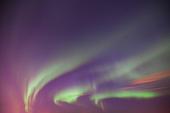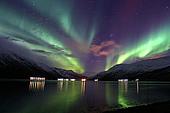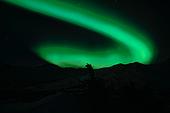Aurora Borealis-北极光
Here is smth new to share about one of the wonders in the world. It is the Aurora Borealis, which is also known as The Northern Lights.

The Northern Lights have had a number of names through history. The scientific name for the phenomena is Aurora Borealis, which is Latin and translates into the red dawn of the north. It was the Italian scientist Galileo Galilei (1564-1642) who first used the expression. On the latitude where Galileo was living, northern lights consist of mainly red colour.

There are many myths regarding The beautiful Northern Lights.
One romantic conception found in Danish folklore is that these lights were due to a throng of swans flying so far to the north that they were caught in the ice. Each time they flapped their wings, they created reflections which created the northern lights.
Another myth was that many native Americans believed that they could conjure up ghosts and spirits by whistling to the lights. It was a common belief that the northern lights were the reflections in the sky of huge fires in the distant north, or that the mighty God himself lighted up the dark and cold parts of the world.

Frequency of occurence
Within the auroral zone, the aurora can be seen every clear winter night. There are other regular variations:
-The aurora is most frequent and intense from 2200 to midnight, magnetic time.
-Brilliant auroras often occur at 27-day intervals as active areas on the sun's surface face earth during its 27-day rotation cycle.
-Northern lights are more frequent in late autumn and early spring. October, February and March are the best months for auroral observations in northern Norway.
-Northern lights activity corresponds closely to sunspot activity, which follows an 11-year cycle, but there seems to be a one-year delay between sunspot maximum and maximum auroral occurrence.
-Northern lights activity is 20-30% less during solar minimum than at solar maximum.
Northern lights are observed in Mediterranean countries only when solar activity is extremely high.

"Some after thoughts: Did we realised that the most beautiful tings in the world often have very short lifespan? But tink abt it..Sometimes it doesnt matter if it has a long or short lifespan, the most impt ting is tt in its short life time it gave its best and its most beautiful....
灿烂但短暂的光辉,你会记得吗?”

The Northern Lights have had a number of names through history. The scientific name for the phenomena is Aurora Borealis, which is Latin and translates into the red dawn of the north. It was the Italian scientist Galileo Galilei (1564-1642) who first used the expression. On the latitude where Galileo was living, northern lights consist of mainly red colour.

There are many myths regarding The beautiful Northern Lights.
One romantic conception found in Danish folklore is that these lights were due to a throng of swans flying so far to the north that they were caught in the ice. Each time they flapped their wings, they created reflections which created the northern lights.
Another myth was that many native Americans believed that they could conjure up ghosts and spirits by whistling to the lights. It was a common belief that the northern lights were the reflections in the sky of huge fires in the distant north, or that the mighty God himself lighted up the dark and cold parts of the world.

Frequency of occurence
Within the auroral zone, the aurora can be seen every clear winter night. There are other regular variations:
-The aurora is most frequent and intense from 2200 to midnight, magnetic time.
-Brilliant auroras often occur at 27-day intervals as active areas on the sun's surface face earth during its 27-day rotation cycle.
-Northern lights are more frequent in late autumn and early spring. October, February and March are the best months for auroral observations in northern Norway.
-Northern lights activity corresponds closely to sunspot activity, which follows an 11-year cycle, but there seems to be a one-year delay between sunspot maximum and maximum auroral occurrence.
-Northern lights activity is 20-30% less during solar minimum than at solar maximum.
Northern lights are observed in Mediterranean countries only when solar activity is extremely high.

"Some after thoughts: Did we realised that the most beautiful tings in the world often have very short lifespan? But tink abt it..Sometimes it doesnt matter if it has a long or short lifespan, the most impt ting is tt in its short life time it gave its best and its most beautiful....
灿烂但短暂的光辉,你会记得吗?”

0 Comments:
Post a Comment
Subscribe to Post Comments [Atom]
<< Home